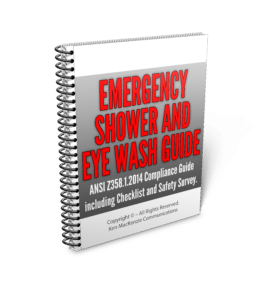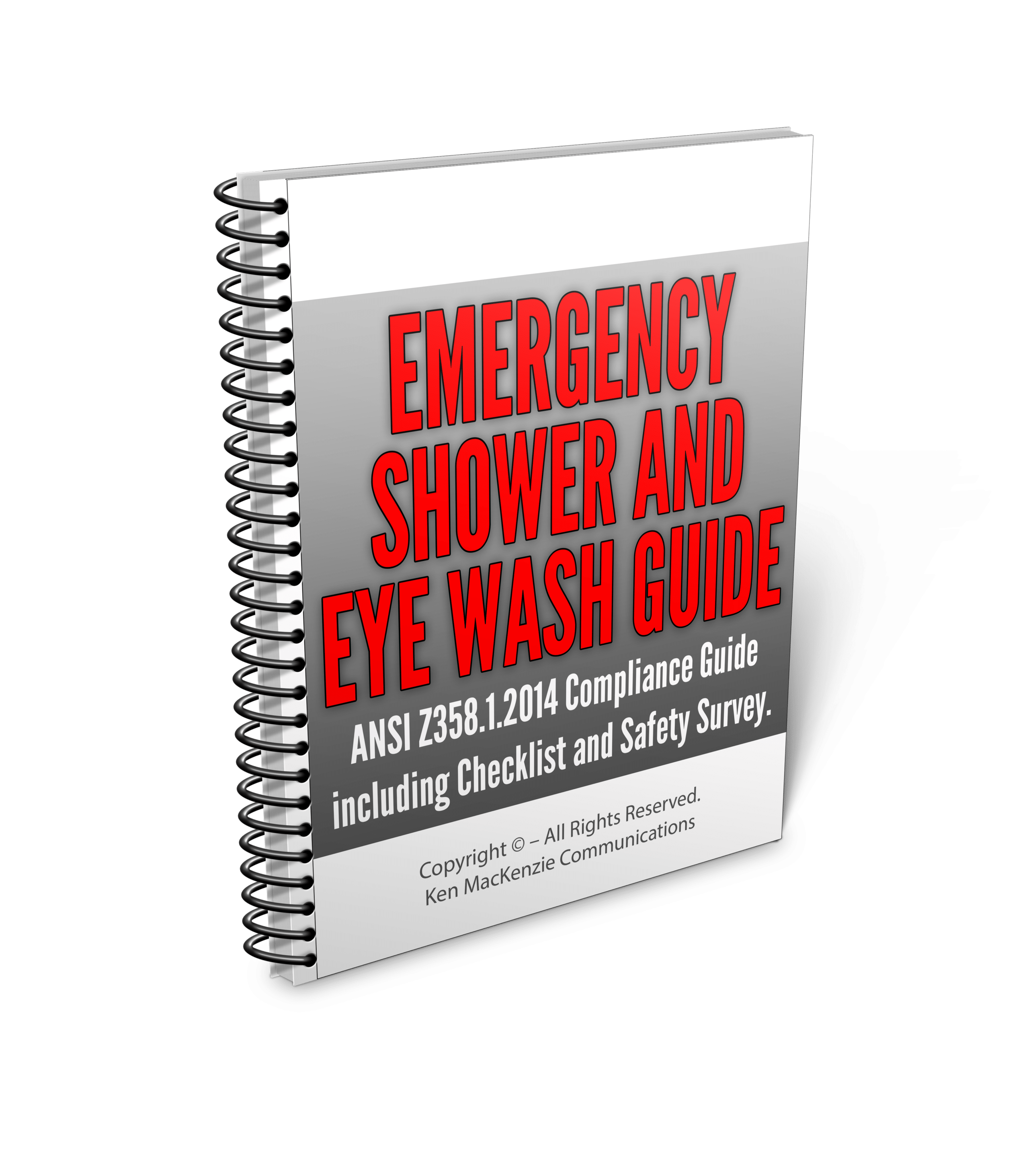Eyewash Station Requirements
Safeguarding Employees’ Well-being
I can’t stress enough the significance of emergency eyewash stations and eyewash station requirements in safeguarding employees’ well-being. These crucial devices are the first line of defense against eye injuries resulting from chemical spills or splashes. To ensure their optimal functionality, it is essential to adhere to the ANSI Z358.1-2014 standard, which outlines strict guidelines for emergency equipment.
In this article, we’ll delve into the world of routine inspections and testing for eyewash stations, unraveling the key elements that keep these life-saving devices ready for action.
Understanding ANSI Z358.1-2014 Eyewash Safety Requirements
Before we plunge into the nitty-gritty of inspections and testing, let’s grasp the importance of the ANSI Z358.1-2014 standard.
This standard acts as a blueprint for emergency eyewash and shower equipment, providing comprehensive guidelines for design, installation, maintenance, and performance. It serves as a benchmark for regulatory compliance and best practices, ensuring that workplaces meet the highest safety standards.
The standard explicitly emphasizes the need for routine inspections and testing of emergency eyewash stations to guarantee their prompt functionality during emergencies. Let’s take a closer look at what these inspections entail.
The Importance of Routine Inspections
Regular inspections are the lifeblood of any safety program, and emergency eyewash stations are no exception. The goal is simple: to confirm that the eyewash equipment is in top-notch condition and can provide immediate aid when needed.
Neglecting routine inspections can have severe consequences, ranging from ineffective response during emergencies to non-compliance with safety regulations.
By conducting frequent inspections, employers demonstrate their commitment to workplace safety, fostering a culture of care and responsibility among employees.
Video: Eyewash Station Requirements:
Frequency and Timing of Inspections
The ANSI Z358.1-2014 standard sets forth a clear schedule for inspections, recommending weekly checks for plumbed eyewash stations and self-contained units. The frequency ensures that any potential issues are promptly identified and resolved before they escalate into safety hazards.
However, it’s not just about the frequency. Timing matters too! Conducting inspections during regular working hours increases the likelihood of detecting problems that might otherwise go unnoticed.
Components of a Comprehensive Inspection
A thorough inspection should cover various critical components of an eyewash station. This includes checking the water flow, ensuring the correct temperature, examining the operation of valves and controls, inspecting the nozzles for clogs or damage, and verifying the presence of clear signage and adequate lighting. Each component plays a crucial role in ensuring the eyewash station’s proper functionality and effectiveness in emergencies.
Testing Procedures and Protocols
Now that we understand what to inspect let’s move on to testing procedures. Regular testing is essential to verify that the eyewash station operates as intended during an emergency. The ANSI Z358.1-2014 standard mandates that plumbed eyewash stations deliver tepid water within one second of activation, while self-contained units must provide a continuous flow for at least 15 minutes.
Testing these crucial aspects involves a step-by-step process, which includes activating the station, measuring the water flow rate, and evaluating the duration of water delivery. Precise testing ensures that any deviations from the standard are detected and addressed promptly.
Addressing Eyewash Station Requirements – Common Issues and Troubleshooting
Even with regular inspections and testing, issues can arise over time. It’s essential to identify common problems that might hinder the eyewash station’s performance and take prompt corrective action. Common issues include low water pressure, clogged nozzles, incorrect water temperature, or leaky valves.
As part of your troubleshooting arsenal, ensure that maintenance personnel are well-trained to address these issues or consult qualified professionals for more complex problems.
Record-Keeping and Documentation
Maintaining detailed records of inspections and testing is not just a regulatory requirement but also a crucial aspect of effective safety management. Accurate documentation allows for easy tracking of inspection dates, testing results, and maintenance activities.
In the unfortunate event of an incident, having proper documentation can serve as evidence of compliance and adherence to safety standards, helping protect your organization from potential liabilities.
Training and Certification for Inspectors
Carrying out comprehensive inspections and testing requires skilled personnel who understand the intricacies of eyewash stations. Investing in training and certification for your inspection team is a wise move. These programs equip inspectors with the necessary knowledge and expertise to conduct inspections effectively, ensuring the equipment’s proper functioning.
Integrating Inspections into Safety Culture
Creating a robust safety culture is an ongoing process that requires active involvement from all employees. By integrating routine inspections as a regular safety practice, organizations instill a sense of responsibility among employees, encouraging them to take an active interest in the well-being of their colleagues.
Encouraging collaboration among employees and involving them in the inspection process fosters a collective commitment to maintaining emergency eyewash stations and other safety measures.
Before You Go…..
The safety of your workforce is non-negotiable, and emergency eyewash stations are indispensable assets in your safety arsenal. Regular inspections and testing are the backbone of ensuring the functionality and compliance of these life-saving devices. By adhering to the ANSI Z358.1-2014 standard and implementing the guidelines provided in this article, you can create a safer work environment for all.
Remember, workplace safety is a collective effort, and each person’s commitment makes a significant impact. So, let’s join hands and make safety a top priority in our workplaces!
Frequently Asked Questions (FAQ’s)
Q: How often should emergency eyewash stations be inspected?
According to the ANSI Z358.1-2014 standard, plumbed and self-contained eyewash stations should undergo weekly inspections.
Q: What is the purpose of routine inspections?
Routine inspections ensure that emergency eyewash stations are in proper working condition, ready to provide immediate aid in case of chemical splashes or spills.
Q: Can employees conduct routine inspections?
While employees can participate in the inspection process by reporting any issues, inspections should be performed by trained personnel or certified inspectors.
Q: Is documentation of inspections necessary?
Yes, documentation of inspections and testing is crucial for compliance and liability purposes. It helps keep track of equipment maintenance and adherence to safety standards.
Q: How can organizations foster a safety culture?
Encouraging open communication, providing safety training, involving employees in safety initiatives, and recognizing safety contributions can foster a strong safety culture.
Note: The information provided in this osha eyewash station requirements article is for informational purposes only and should not be considered as professional advice. Always consult qualified professionals for specific safety recommendations and guidance for your workplace.
Links on this osha eyewash station requirements page are sponsored affiliate links and the owner makes commission if you buy after clicking these links. The owner is not a bona-fide user of these osha eyewash station requirements. However, he has thoroughly researched osha eyewash station requirements and provided a personal opinion only. This disclosure is in accordance with the Federal Trade Commission’s 16 CFR, Part 255: “Guides Concerning the Use of Endorsements and Testimonials in Advertising.”
Filed under: ANSI Z358.1 2014


